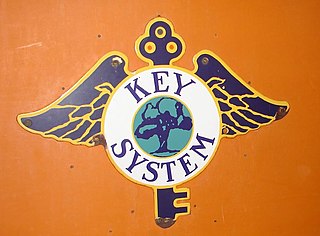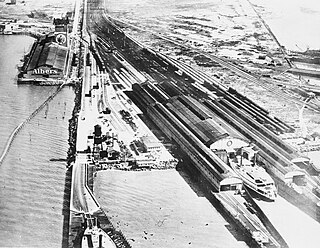
The Key System was a privately owned company that provided mass transit in the cities of Oakland, Berkeley, Alameda, Emeryville, Piedmont, San Leandro, Richmond, Albany, and El Cerrito in the eastern San Francisco Bay Area from 1903 until 1960, when it was sold to a newly formed public agency, AC Transit. The Key System consisted of local streetcar and bus lines in the East Bay, and commuter rail and bus lines connecting the East Bay to San Francisco by a ferry pier on San Francisco Bay, later via the lower deck of the Bay Bridge. At its height during the 1940s, the Key System had over 66 miles (106 km) of track. The local streetcars were discontinued in 1948 and the commuter trains to San Francisco were discontinued in 1958. The Key System's territory is today served by BART and AC Transit bus service.
Solano Avenue in Berkeley and Albany, California is a two-mile (3.2 km) long east-west street. Solano Avenue is one of the larger shopping districts in the Berkeley area. Businesses along Solano Avenue cover a wide range, including grocery stores, coffee shops, drugstores, bookstores, antique dealers, apparel outlets, ethnic restaurants and a movie theater.

The Steel Electric-class ferries are a class of auto/passenger ferries that became part of the Washington State Ferry System when Puget Sound Navigation Company was acquired in 1951. They were built on San Francisco Bay for service on Southern Pacific and Northwestern Pacific Railroad routes across that bay.

The Hyde Street Pier, at 2905 Hyde Street, is a historic ferry pier located on the northern waterfront of San Francisco, California.

The East Bay Electric Lines were a unit of the Southern Pacific Railroad that operated electric interurban-type trains in the East Bay region of the San Francisco Bay Area. Beginning in 1862, the SP and its predecessors operated local steam-drawn ferry-train passenger service in the East Bay on an expanding system of lines, but in 1902 the Key System started a competing system of electric lines and ferries. The SP then drew up plans to expand and electrify its system of lines and this new service began in 1911. The trains served the cities of Berkeley, Albany, Emeryville, Oakland, Alameda, and San Leandro transporting commuters to and from the large Oakland Pier and SP Alameda Pier. A fleet of ferry boats ran between these piers and the docks of the Ferry Building on the San Francisco Embarcadero.

The Sacramento Northern Railway was a 183-mile (295 km) electric interurban railway that connected Chico in northern California with Oakland via the California capital, Sacramento. In its operation it ran directly on the streets of Oakland, Sacramento, Yuba City, Chico, and Woodland and ran interurban passenger service until 1941 and freight service into the 1960s.

The Oakland Long Wharf was an 11,000-foot railroad wharf and ferry pier along the east shore of San Francisco Bay located at the foot of Seventh Street in West Oakland. The Oakland Long Wharf was built, beginning 1868, by the Central Pacific Railroad on what was previously Oakland Point. Beginning November 8, 1869, it served as the west coast terminus of the First Transcontinental Railroad. In the 1880s, Southern Pacific Railroad took over the CPRR, extending it and creating a new ferry terminal building with the official station name Oakland Pier. The entire structure became commonly and popularly called the Oakland Mole. Portions of the Wharf lasted until the 1960s. The site is now part of the facilities of the Port of Oakland, while passenger service runs to the nearby Jack London Square/Dellums Station

San Francisco Bay in California has been served by ferries of all types for over 150 years. John Reed established a sailboat ferry service in 1826. Although the construction of the Golden Gate Bridge and the San Francisco–Oakland Bay Bridge led to the decline in the importance of most ferries, some are still in use today for both commuters and tourists.

The South Pacific Coast Railroad (SPC) was a 3 ft narrow gauge steam railroad running between Santa Cruz, California and Alameda, with a ferry connection in Alameda to San Francisco. The railroad was created as the Santa Clara Valley Railroad, founded by local strawberry growers as a way to get their crops to market in San Francisco and provide an alternative to the Southern Pacific Railroad. In 1876, James Graham Fair, a Comstock Lode silver baron, bought the line and extended it into the Santa Cruz Mountains to capture the significant lumber traffic coming out of the redwood forests. The narrow-gauge line was originally laid with 52-pound-per-yard (26 kg/m) rail on 8-foot (2.44 m) redwood ties; and was later acquired by the Southern Pacific and converted to 4 ft 8+1⁄2 instandard gauge.

The Richmond–San Rafael Ferry Company (originally Richmond–San Rafael Ferry and Transportation Company was a ferry service between Castro Point in Richmond, California in Contra Costa County and San Quentin in Marin County across the San Pablo Bay. It ran from 1915 until the 1956 opening of the Richmond–San Rafael Bridge.
The San Francisco and Oakland Railroad (SF&O) was built in 1862 to provide ferry-train service from a San Francisco ferry terminal connecting with railroad service through Oakland to San Antonio. In 1868 Central Pacific Railroad decided that Oakland would be the west coast terminus of the First transcontinental railroad and bought SF&O. Beginning November 8, 1869, part of the SF&O line served as the westernmost portion of the transcontinental railroad. It subsequently was absorbed into the Southern Pacific Railroad (SP). The track in Oakland was electrified in 1911 and extended across the San Francisco-Oakland Bay Bridge in 1939. Service was abandoned in 1941.
The San Francisco and Alameda Railroad (SF&A) was a short-lived railroad company in the East Bay area of the San Francisco Bay Area. The railroad line opened 1864–1865 from Alameda Terminal on Alameda Island to Hayward, California, with ferry service between Alameda Terminal and San Francisco started in 1864. After being bankrupted by the 1868 Hayward earthquake, it was acquired by a subsidiary of the Central Pacific Railroad in August 1869. Part of the SF&A line between Alameda Terminal and San Leandro served as a portion of the First Transcontinental Railroad starting in September 1869, while the southern section was abandoned in 1873.
The Western Pacific Railroad (1862-1870) was formed in 1862 to build a railroad from Sacramento, California, to the San Francisco Bay, the westernmost portion of the First Transcontinental Railroad. After the completion of the railroad from Sacramento to Alameda Terminal on September 6, 1869, and then the Oakland Pier on November 8, 1869, which was the Pacific coast terminus of the transcontinental railroad, the Western Pacific Railroad was absorbed in 1870 into the Central Pacific Railroad.
Thousand Oaks is a neighborhood of Berkeley in Alameda County, California. Located at the base of the Berkeley Hills, it lies at an elevation of 239 feet.

The Northbrae Tunnel, also referred to as the Solano Avenue Tunnel, was built as a commuter electric railroad tunnel in the northern part of Berkeley, California, and was later converted to street use.
Sierra Nevada was a steel-hulled steam-powered passenger ferry operated on San Francisco Bay. The ferry was built for the Western Pacific Railroad as Edward T. Jeffery in 1913 and subsequently renamed Feather River. The ferry offered connecting service to San Francisco for Western Pacific train passengers arriving in Oakland, California. The ferry was sold to Southern Pacific Transportation Company when Western Pacific began using Southern Pacific's Oakland ferry facilities in May, 1933. Southern Pacific renamed the ferry Sierra Nevada and placed it in commuter service between San Francisco and Alameda, California until that route was discontinued in 1939. The ferry was leased to the Key System for the Golden Gate International Exposition on Treasure Island from 1939 through 1940. In 1942, the ferry was requisitioned by the federal government to carry shipyard workers from San Francisco to Richmond Yard 1 through World War II. The Richmond-San Rafael Ferry Company purchased the ferry in 1947 and rebuilt it to carry automobiles between Richmond and San Rafael until the Richmond–San Rafael Bridge opened on 1 September 1956. The ferry was then towed to San Pedro, Los Angeles where she sank in 1978.
Six Minute Ferry operated an automobile ferry service across Carquinez Strait on the main highway between Sacramento and Oakland, California. Each crossing near the present Interstate 80 bridge took approximately 6 minutes. As automobile travel became increasingly popular, the company ordered some new steel ferries in 1921. The ferry company went out of business while the ferries were under construction after a March 1922 landslide destroyed the Six Minute Ferry north shore terminal on Morrow Cove. Southern Pacific Transportation Company purchased the ferries ordered by Six Minute Ferry and placed them in service between San Francisco and Oakland. The three ferries remained in service on various San Francisco Bay routes until completion of the San Francisco–Oakland Bay Bridge in 1936 and the Golden Gate Bridge in 1937.
Melrose was the first San Francisco Bay ferry designed to carry automobiles. Southern Pacific Transportation Company and predecessor railroads had been operating ferries between San Francisco and Oakland, California since 1862. Some ferries were equipped to carry team-drawn wagons, but the increasing number of automobiles requiring transport encouraged building of a ferry with an unobstructed lower deck for automobiles and 400 seats on an upper deck for passengers. Melrose was launched without engines on 11 April 1906. Installation of engines being built at San Francisco's Union Iron Works was delayed by the 1906 San Francisco earthquake a week after launching. The ferry was not completed until 1909. The side wheels were powered by two inclined tandem engines to avoid main deck obstruction by a traditional walking beam engine.
Alameda was the first of three large-capacity ferries intended to transport passengers across San Francisco Bay. Southern Pacific Transportation Company and predecessor railroads had been operating ferries between San Francisco and Oakland, California since 1862. By the early 20th century, service had stabilized on three routes to the San Francisco Ferry Building from Oakland Pier, Alameda, and the San Antonio Creek estuary. Each route required two ferries shuttling back and forth to meet the departure schedule, with a third ferry in reserve when one boat needed maintenance or repair. Southern Pacific's engineering department designed Alameda for the heavily traveled Oakland Pier route as passenger counts rose during the period of prosperity preceding World War I. Alameda used side wheels for propulsion; but, instead of being powered by a single walking beam engine, wheels were powered independently by two engines for greater maneuverability. The twin stacks were distinctive among 20th century San Francisco Bay ferries.
Golden Gate Ferry Company was a private company which operated automobile ferries between San Francisco, Berkeley and Sausalito before the opening of the Bay Bridge and the Golden Gate Bridge. The company was incorporated in November 1920. The ferry went bankrupt at the completion of the Golden Gate Bridge, but with the start of World War 2 the demand for service was so great it started again. Ferry service started just one year after closing to ferry shipyard workers to the Marinship and Kaiser Shipyards shipyard in San Francisco. But after the war, service was discontinued again. In early 1929, the Golden Gate Ferry Company merged with the ferry system of the Southern Pacific railroad, becoming the Southern Pacific-Golden Gate Ferries, Ltd.










